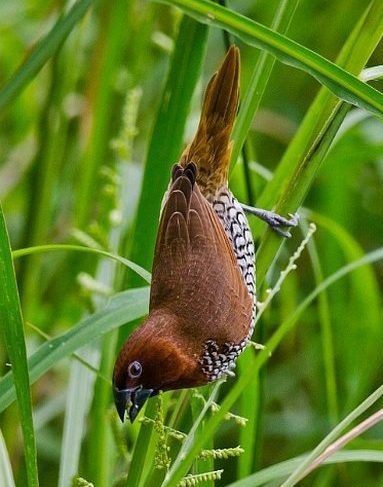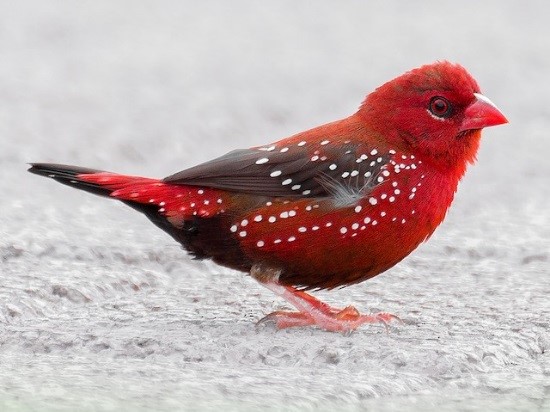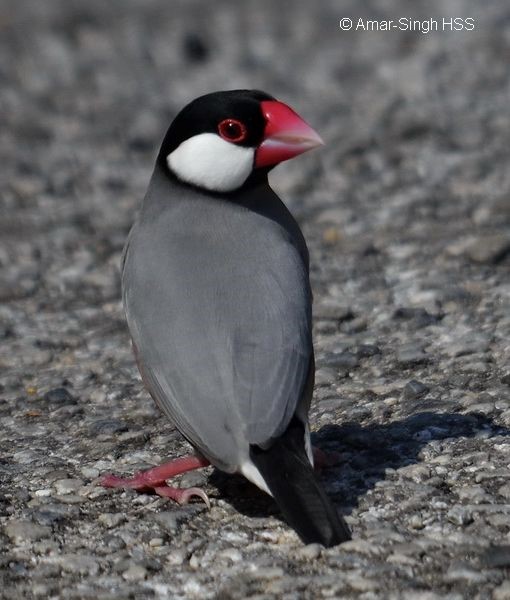Estrildidae: Waxbills
The waxbills are a large family of small finches native to the Old World tropics from Africa to Polynesia. As with most other birds that are generically known as finches, their bills are deep-based and short, approximately triangular, which is the optimal shape for a diet that consists primarily of seeds. Their bills appear smooth-surfaced and many are brightly colored—hence the family name.
Most waxbills are highly gregarious and spend most of their time in flocks—often very large flocks—that roam in search of seed profusions. Having located a suitable supply, they consume it assiduously, muttering soft contact calls to reassure one another. When one detects a threat, the flock suddenly erupts with an audible whirring of dozens of little wings. In many instances they fly a short distance, watch and wait for the danger to pass, then return to the same patch of grass (with a good seed crop in view, they evidently prefer to harvest it rather than find another one).
Like their bills, the plumages of many waxbills are brightly colored. Splashes of red on the face and rump are especially popular, but several African and Australasian waxbill clans draw from a broader palette and collectively the family covers most of the rainbow. Besides vividness, the plumages of most species are strikingly patterned, with crisp lines of contrast between different hues and neatly organized spots or bars.
The combination of good looks and a readily supplied seed diet, along with a generally docile temperament, has made waxbills a staple of the cagebird trade, and many species are widely available through both legal and illicit channels. (In aviculturist jargon, “finch” is nearly synonymous with “waxbill.”) Most species reproduce quickly enough to absorb this exploitation without significant depletion of native populations. There are notable exceptions, however, such as the Java Sparrow (Lonchura oryzivora), whose popularity as a cagebird has resulted in near-extinction in its natural range—although its unpopularity as an agricultural pest may also be a strong factor.
The cagebird trade has taken the Java Sparrow and many other waxbill species to distant lands, where escapes and releases have enabled them to establish viable populations. While the Java Sparrow is endangered in Indonesia, it has become abundant in Hawaii—such that it may be appropriate to designate it as a predominantly Hawaiian species, an immigrant-turned-naturalized-citizen, and a partial replacement for the many indigenous Hawaiian birds extinguished through human colonization of the islands.
The history of international trade in waxbills appears to be nearly as old as that of maritime commerce—dating back at least as far as the 1500s—so some introduced populations are several centuries old. For example, the current Caribbean populations of Orange-cheeked Waxbill (Estrilda melpoda) and Bronze Mannikin (Spermestes cucullata) are a legacy of human slavery, carried on the same ships that brought humans as cargo from West Africa to the sugarcane plantations.
Taxonomy
The species-level taxonomy of the Estrildidae is mostly settled, with a few borderline cases of speciation in progress that are difficult to resolve. The total number of waxbill species, as currently understood, is in the range of 141 to 152, in three subfamilies:
Estrildinae: Waxbills (88 to 96 species)
Erythurinae: Parrotfinches (13 species)
Lonchurinae: Munias (40 to 43 species)
Woodhouse’s Antpecker (Parmoptila woodhousei)
Red-fronted Antpecker (Parmoptila rubrifrons)
Jameson’s Antpecker (Parmoptila jamesoni)
White-breasted Nigrita (Nigrita fusconotus)
Chestnut-breasted Nigrita (Nigrita bicolor)
Pale-fronted Nigrita (Nigrita luteifrons)
Gray-headed Nigrita (Nigrita canicapillus)
Shelley’s Oliveback (Nesocharis shelleyi)
White-collared Oliveback (Nesocharis ansorgei)
Gray-headed Oliveback (Nesocharis capistrata)
Red-billed Pytilia (Pytilia lineata)
Red-winged Pytilia (Pytilia phoenicoptera)
Yellow-winged Pytilia (Pytilia hypogrammica)
Orange-winged Pytilia (Pytilia afra)
Green-winged Pytilia (Pytilia melba)
Red-headed Finch (Amadina erythrocephala)
Cut-throat Finch (Amadina fasciata)
Green Twinspot (Mandingoa nitidula)
“Orange-breasted Twinspot” (M. n. schlegeli)
“Green-breasted Twinspot” (M. n. nitidula)
Red-faced Crimsonwing (Cryptospiza reichenovii)
“Western Crimsonwing” (C. r. reichenovii)
“Eastern Crimsonwing” (C. r. australis)
Abyssinian Crimsonwing (Cryptospiza salvadorii)
Dusky Crimsonwing (Cryptospiza jacksoni)
Shelley’s Crimsonwing (Cryptospiza shelleyi)
Black-bellied Seedcracker (Pyrenestes ostrinus)
Crimson Seedcracker (Pyrenestes sanguineus)
Lesser Seedcracker (Pyrenestes minor)
Grant’s Bluebill (Spermophaga poliogenys)
Western Bluebill (Spermophaga haematina)
“Western Bluebill” (S. h. haematina)
“Red-rumped Bluebill” (S. h. pustulata)
Red-headed Bluebill (Spermophaga ruficapilla)
Brown Twinspot (Clytospiza monteiri)
Pink-throated Twinspot (Hypargos margaritatus)
Red-throated Twinspot (Hypargos niveoguttatus)
Dybowski’s Twinspot (Euschistospiza dybowskii)
Dusky Twinspot (Euschistospiza cinereovinacea)
“Angolan Twinspot” (E. c. cinereovinacea)
“Grauer’s Twinspot” (E. c. graueri)
Black-bellied Firefinch (Lagonosticta rara)
Bar-breasted Firefinch (Lagonosticta rufopicta)
Brown Firefinch (Lagonosticta nitidula)
Red-billed Firefinch (Lagonosticta senegala)
Rock Firefinch (Lagonosticta sanguinodorsalis)
Chad Firefinch (Lagonosticta umbrinodorsalis)
Mali Firefinch (Lagonosticta virata)
African Firefinch (Lagonosticta rubricata)
Landana Firefinch (Lagonosticta landanae)
Jameson’s Firefinch (Lagonosticta rhodopareia)
Black-faced Firefinch (Lagonosticta larvata)
“Vinaceous Firefinch” (L. l. vinacea)
“Gray Firefinch” (L. l. nigricollis)
“Reddish Firefinch” (L. l. larvata)
Southern Cordonbleu (Uraeginthus angolensis)
Red-cheeked Cordonbleu (Uraeginthus bengalus)
Blue-capped Cordonbleu (Uraeginthus cyanocephalus)
Violet-eared Waxbill (Uraeginthus granatinus)
Purple Grenadier (Uraeginthus ianthinogaster)
Yellow-bellied Waxbill (Coccopygia quartinia)
Swee Waxbill (Coccopygia melanotis)
Angolan Waxbill (Coccopygia bocagei)
Lavender Waxbill (Estrilda caerulescens)
Gray Waxbill (Estrilda perreini)
Cinderella Waxbill (Estrilda thomensis)
Anambra Waxbill (Estrilda poliopareia)
Fawn-breasted Waxbill (Estrilda paludicola)
Abyssinian Waxbill (Estrilda ochrogaster)
Orange-cheeked Waxbill (Estrilda melpoda)
Crimson-rumped Waxbill (Estrilda rhodopyga)
Arabian Waxbill (Estrilda rufibarba)
Black-rumped Waxbill (Estrilda troglodytes)
Common Waxbill (Estrilda astrild)
Black-lored Waxbill (Estrilda nigriloris)
Black-crowned Waxbill (Estrilda nonnula)
Black-headed Waxbill (Estrilda atricapilla)
Kandt’s Waxbill (Estrilda kandti)
Black-faced Waxbill (Estrilda erythronotos)
Black-cheeked Waxbill (Estrilda charmosyna)
Red Avadavat (Amandava amandava)
Green Avadavat (Amandava formosa)
Orange-breasted Waxbill (Amandava subflava)
Quailfinch (Ortygospiza atricollis)
Locust Finch (Paludipasser locustella)
Painted Finch (Emblema pictum)
Beautiful Firetail (Stagonopleura bella)
Red-eared Firetail (Stagonopleura oculata)
Diamond Firetail (Stagonopleura guttata)
Mountain Firetail (Oreostruthus fuliginosus)
Red-browed Finch (Neochmia temporalis)
Crimson Finch (Neochmia phaeton)
Star Finch (Neochmia ruficauda)
Plum-headed Finch (Neochmia modesta)
Masked Finch (Poephila personata)
“Masked Finch” (P. p. personata)
“White-eared Finch” (P. p. leucotis)
Long-tailed Finch (Poephila acuticauda)
Black-throated Finch (Poephila cincta)
Zebra Finch (Taeniopygia guttata)
“Sundan Zebra Finch” (T. g. guttata)
“Australian Zebra Finch” (T. g. castanotis)
Double-barred Finch (Taeniopygia bichenovii)
Tawny-breasted Parrotfinch (Erythrura hyperythra)
Pin-tailed Parrotfinch (Erythrura prasina)
Green-faced Parrotfinch (Erythrura viridifacies)
Tricolored Parrotfinch (Erythrura tricolor)
Red-eared Parrotfinch (Erythrura coloria)
Blue-faced Parrotfinch (Erythrura trichroa)
Papuan Parrotfinch (Erythrura papuana)
Red-throated Parrotfinch (Erythrura psittacea)
Red-headed Parrotfinch (Erythrura cyaneovirens)
Royal Parrotfinch (Erythrura regia)
Fiji Parrotfinch (Erythrura pealii)
Pink-billed Parrotfinch (Erythrura kleinschmidti)
Gouldian Finch (Erythrura gouldiae)
African Silverbill (Euodice cantans)
Indian Silverbill (Euodice malabarica)
Gray-headed Silverbill (Odontospiza caniceps)
Bronze Mannikin (Spermestes cucullata)
Black-and-white Mannikin (Spermestes bicolor)
Red-backed Mannikin (Spermestes nigriceps)
Magpie Mannikin (Spermestes fringilloides)
Madagascar Mannikin (Lepidopygia nana)
White-rumped Munia (Lonchura striata)
Javan Munia (Lonchura leucogastroides)
Dusky Munia (Lonchura fuscans)
Moluccan Munia (Lonchura molucca)
Scaly-breasted Munia (Lonchura punctulata)
“Checkered Munia” (L. p. punctulata)
“Spotted Munia” (L. p. nisoria)
Black-throated Munia (Lonchura kelaarti)
White-bellied Munia (Lonchura leucogastra)
Streak-headed Munia (Lonchura tristissima)
White-spotted Munia (Lonchura leucosticta)
Five-colored Munia (Lonchura quinticolor)
Tricolored Munia (Lonchura malacca)
Chestnut Munia (Lonchura atricapilla)
“Chestnut Munia” (L. a. atricapilla)
“Brown-headed Munia” (L. a. brunneiceps)
White-capped Munia (Lonchura ferruginosa)
White-headed Munia (Lonchura maja)
Pale-headed Munia (Lonchura pallida)
Great-billed Mannikin (Lonchura grandis)
Gray-banded Mannikin (Lonchura vana)
Gray-headed Mannikin (Lonchura caniceps)
Gray-crowned Mannikin (Lonchura nevermanni)
Hooded Mannikin (Lonchura spectabilis)
Forbes’s Mannikin (Lonchura forbesi)
Hunstein’s Mannikin (Lonchura hunsteini)
Yellow-rumped Mannikin (Lonchura flaviprymna)
Chestnut-breasted Mannikin (Lonchura castaneothorax)
Black Mannikin (Lonchura stygia)
Black-breasted Mannikin (Lonchura teerinki)
Eastern Alpine Mannikin (Lonchura monticola)
Western Alpine Mannikin (Lonchura montana)
Buff-bellied Mannikin (Lonchura melaena)
Java Sparrow (Lonchura oryzivora)
Timor Sparrow (Lonchura fuscata)
Pictorella Mannikin (Heteromunia pectoralis)
References
Clement, P., A. Harris, and J. Davis. 1993. Finches and Sparrows: An Identification Guide. Princeton University Press, Princeton, N.J.
Restall, R. 1997. Munias and Mannakins. Yale University Press, New Haven.
Roberson, D. 2016. Bird Families of the World: Estrildid Finches: Estrildidae, http://creagrus.home.montereybay.com/estrildids.html. (Posted March 24, 2016. Accessed March 31, 2020.)


